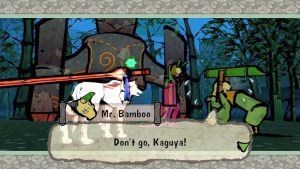
Japanese Mythology, Folklore and Ōkami

This video game makes it clear from the beginning, that its player will get to play as the wolf-incarnation of the Japanese sun goddess Amaterasu – the leader of all Japanese gods. Beyond the more obvious references to Japan’s Shinto kami (spirit/god) worship and mythology, what may be surprising is just how many references to Japan’s folklore are present:

When playing through Ōkami, it feels like an adventure rather than an education. As a newcomer to Japanese folklore, by the end of the game and without realising it, you will have memorised the index and primer to an encyclopedia of some of Japan’s most famous folktales.

Ōkami’s creators had a rich supply of ancient Japanese stories to base the video game’s characters, places and situations on. To piece together so much information without weighing down the main theme of Ōkami’s story, was quite a feat: New perspectives and interpretations of ancient folklore added real depth without confusion.

Ōkami’s story, combined with the distinctly Japanese art style but also reaching out to an international audience, creates a very Japanese video game that can still be understood by those who only know of their own surroundings. The stories told in this video game, are shared in some form and extent by all humans, but the main struggle and adventure played out, is the one each of us are facing every day: That despite the hardships we go through, our existence in this world can leave a meaningful and worthy influence, no matter how small.

At the beginning of Ōkami, you don’t start out as an almighty beast of righteousness that crushes every demonic force there is – you start out as someone who needs to humbly regain the strength that comes from being at ones’ best. In other words, no matter how powerful one is, they started out weak and dependent on those around them – taking on more responsibility and gaining strength, on the journey of their lives.

Playing through this video game, you’ll witness moments relating to your own life, and because these moments are based on the ancient and timeless stories, hopes and lessons of people long gone, you’ll see a connection to the shared reality of not only the eternal struggle, but also the eternal potential.
In future updates to this page, you will find more specific details on some interesting elements of Japanese folklore and how they relate to Ōkami and also to the folklore of other nations.
For now however, embedded below are a series of three videos from YouTube made by “Talekeeper Sherry” – they will power up your understanding of Ōkami’s connections to Japanese Mythology and folklore. He has clearly put a lot of research into his work, however you might need to pause and rewind at times, because goodness, it’s just so much information so quickly. Highly recommended!
More information
Ōkami’s section on the “Let’s Play Archive” is rich and easy to read:
“Mythology Dissection”: LPArchive.org/Ōkami/Supplemental 1/
By the way, as you look through various sources of information on Japanese mythology, folklore, Shinto, etc. you’ll undoubtedly come across conflicting information/interpretations. Even the links posted above have some conflicting details when discussing the same thing.
The main reason for this, is because the subject is not only very complicated, but also because the authentic Japanese sources – the last remaining ancient texts – themselves have conflicting information. 
As with all things that matter to you: take time to look at multiple sources of information, educate yourself on different points of view, and make up your mind based on a solid foundation of research. Any single source of information, even an encyclopedia, may only present a single (biased) interpretation and point of view.
Generally, it would appear that to Japanese people, Shinto is more a “way of life” rather than a religion, and that calling it “kami-worship” may be a more accurate description. Kami may best be described as “gods/spirits”. To simplify the explanations on this fansite, words more familiar to Western audiences like “Shinto religion” and “gods” will be used.
If you want to know more about Japanese Shinto, mythology and folklore, the following links may be a good starting point:
Encyclopedia of Shinto: http://k‑amc.kokugakuin.ac.jp/DM/dbTop.do?class_name=col_eos
(More links in the next update)
We’re still working on expanding this page. If you’d like to make suggestions, please see the contact page.
- Discovering common ground between folklore of different nations
- Adding information on Shinto from various definitive sources
See our Planned Updates & Updates Log blog post for more details.
Share this page:
Sources:
- (“Mythology dissection”) https://www.LPArchive.org/Ōkami/
- (“Kitsune Hawk” Ōkami mythology series.) https://www.youtube.com/watch?v=j7zvIxIGWus | https://www.youtube.com/watch?v=2Yj0NpoICOw | https://www.youtube.com/watch?v=qaOCukDAk58
- TBA
- TBA
(Accessed February 2020 – April 2020)
Header image is a montage of Japanese art of Susanoo in combat with Yamata no Orochi and official Ōkami art by Clover Studio/Capcom (showing “Susano’s” victory, standing on “Orochi’s” corpse).
Additional sources, and how we choose and link sources: Website Art, Graphics & Other Sources, Plus Posting & Linking Policies
Consider Basic Internet Browsing & Safety Tips, when visiting these and other websites. No links to other websites are affiliate links: advice is 100% free & independent.
